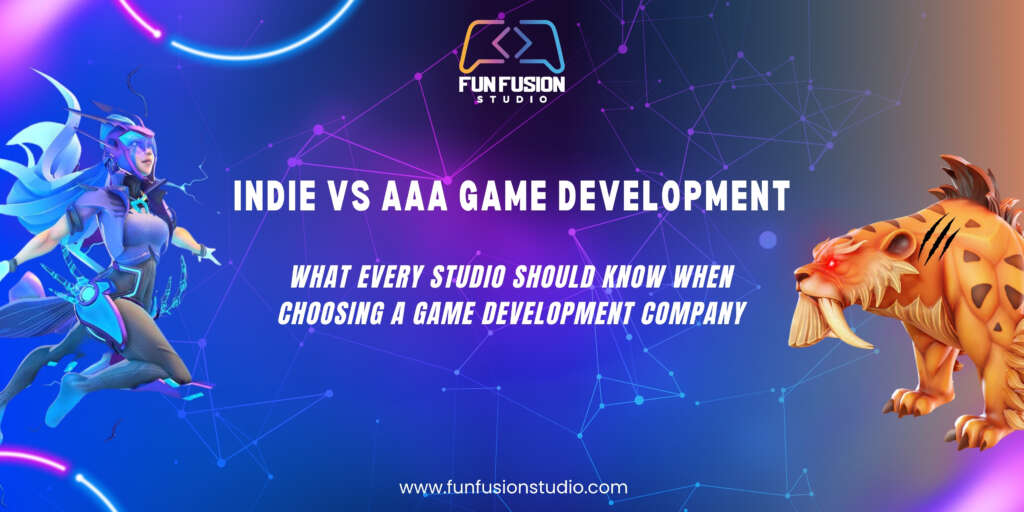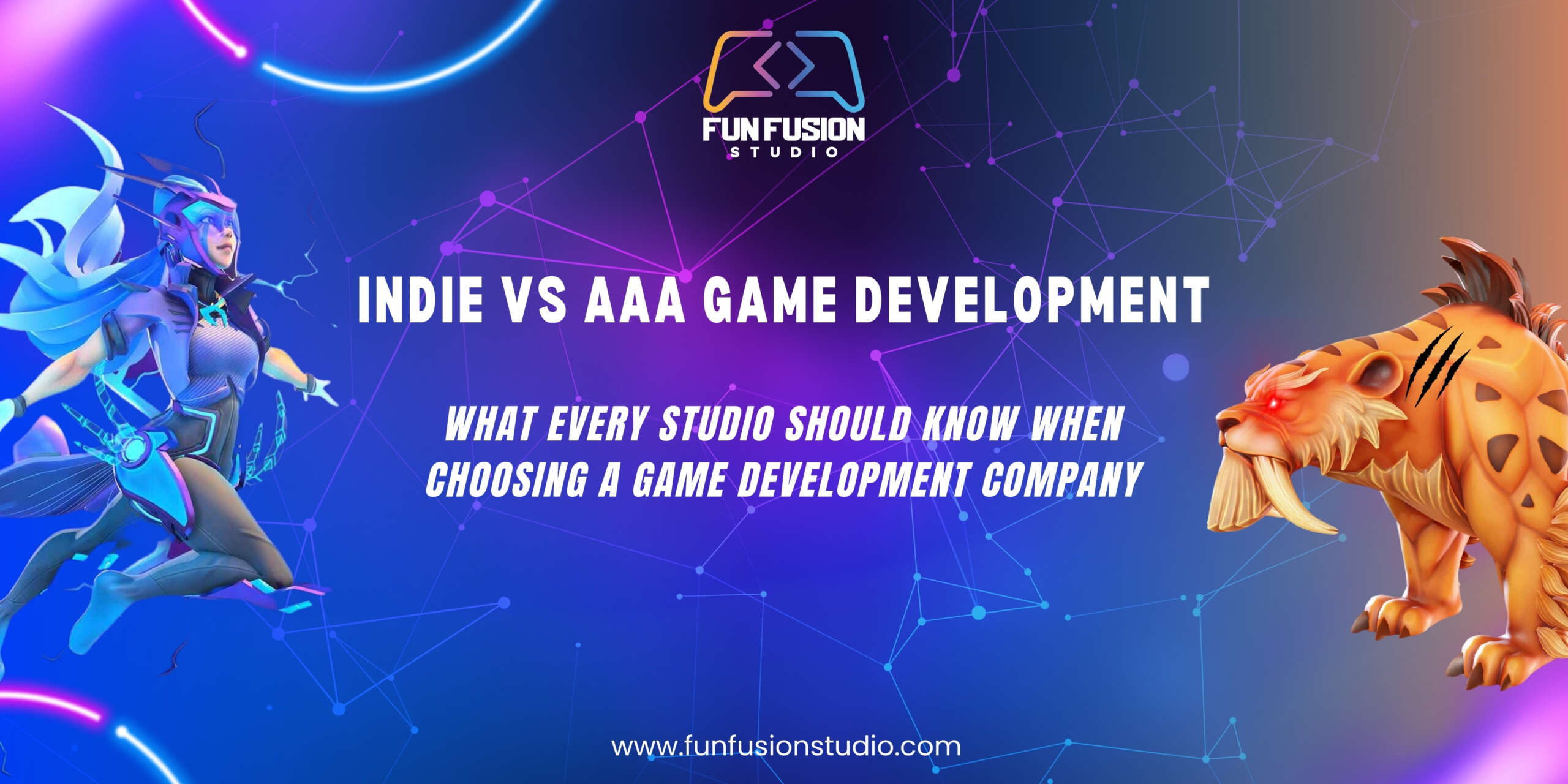
Introduction
If you’re thinking about launching a game, you’ve probably asked yourself: Should I go indie or aim for AAA-level development?
For aspiring game publishers and startup founders, this isn’t just a question of scale — it’s a strategic decision that impacts your budget, timeline, creative direction, and success potential.
At FunFusionStudio, we work with founders and businesses at every level of game development. And over the years, we’ve seen that one of the biggest turning points for new game creators is choosing the right development model: Indie, AA, or AAA.
This blog post is your guide to making that decision. We’ll break down what sets each model apart, when to consider one over the other, and how to align your vision with the right game development company.
Whether you’re creating your first mobile puzzle game or envisioning the next open-world blockbuster, this guide is built to help you make informed, confident choices.
What Defines Indie, AA & AAA Studios
Let’s clear up the buzzwords.
The terms Indie, AA, and AAA don’t just describe how big a game looks — they represent how it’s made, who funds it, and how it’s marketed. Each model comes with its own advantages, risks, and expectations.
Here’s a quick breakdown:
| Category | Indie | AA | AAA |
| Budget | $10K – $500K | $1M – $10M | $10M+ |
| Team Size | 1–20 people | 20–100 people | 100+ developers |
| Funding Source | Self-funded, crowdfunded | Studio-backed, mid-tier publishers | Large publishers, investors |
| Creative Control | High | Moderate | Low (often dictated by publishers) |
| Production Timeline | 6–18 months | 1–2 years | 3–5 years or more |
| Typical Genres | Puzzle, platformers, narrative | RPGs, tactical shooters | Open-world, action-adventure |
Indie Game Studios
These are small, agile teams — sometimes even solo developers — creating games with personal vision. The hallmark of indie development is creative freedom. Think games like Celeste or Hollow Knight.
AA Studios
Sitting between indie and AAA, AA studios have modest backing and often aim for niche excellence. Their projects balance creativity with reasonable production values. Titles like Hellblade: Senua’s Sacrifice exemplify this model.
AAA Studios
This is the big league. AAA games are built with multi-million-dollar budgets, hundreds of developers, and years of planning. They’re designed for mass-market appeal — examples include The Witcher 3, Call of Duty, or Assassin’s Creed.
Understanding which model your idea fits into is step one in choosing the right game development company to partner with.
3. Key Comparison Factors
Choosing between indie and AAA development is more than just a matter of budget — it’s about how you want to build, launch, and support your game. Let’s look at the core differences that can influence your decision as a founder or game publisher.
1. Budget & Funding Sources
| Factor | Indie | AAA |
| Typical Budget Range | $10K – $500K | $10M+ |
| Funding | Self-funded, Kickstarter, or small investors | Backed by major publishers or VC |
| Revenue Model | Leaner, direct-to-player | High-risk, high-reward |
Startups often choose indie development because it’s more financially feasible. But as funding grows, so do expectations — from team expansion to visual fidelity and marketing.
2. Team Size & Specialization
- Indie teams are small, often cross-functional — one person might handle both design and marketing.
- AAA teams are highly specialized, with departments for animation, sound design, engine optimization, etc.
If you’re launching with limited resources, a compact indie team can deliver faster and with greater flexibility. AAA demands full-time dedication across multiple roles.
3. Creative Freedom vs. Stakeholder Demands
- Indie studios are self-guided, allowing you to chase bold or experimental ideas.
- AAA projects are stakeholder-driven, where publishers have a say in creative direction, monetization, and timeline.
This matters if you’re a founder with a strong creative vision — indie gives you control, while AAA can impose structure.
4. Technology & Tools
- Indie devs commonly use tools like Unity, Godot, or GameMaker.
- AAA companies may rely on proprietary engines or high-end platforms like Unreal Engine 5, supported by advanced pipelines.
Advanced tools offer cinematic quality, but they also demand higher skill, time, and cost.
5. Timeline
Indie games might go from concept to launch in under a year. AAA productions often take 3–5 years, sometimes longer. For startups trying to prove concept or build early traction, speed matters — and indie timelines work better.
4. Platform & Scope: Indie vs AAA Use Cases
As you shape your idea, one of the key questions is: What kind of experience are you building — and for whom?
Here’s how scope typically differs:
| Attribute | Indie | AAA |
| Game Length | Short to medium | 40+ hours gameplay |
| Art Style | Stylized, experimental | Cinematic, photorealistic |
| Platform Focus | Mobile, PC, Nintendo Switch | PC, PlayStation, Xbox, Cloud |
| Gameplay | Unique mechanics, innovative storytelling | Large-scale world-building, multiplayer, realism |
Common Indie Game Scenarios
- Puzzle game for iOS
- Narrative-heavy platformer for PC
- Stylized pixel-art game with niche appeal
These projects don’t need massive budgets — but they thrive on creativity and fast iteration.
Common AAA Game Scenarios
- First-person shooter for PlayStation and Xbox
- Open-world fantasy RPG
- Cross-platform multiplayer battle royale
These require robust dev teams, QA, and polished gameplay loops to meet player expectations at scale.
If your goal is to test an innovative mechanic, indie is your best friend. But if you’re building a game to rival the big names, you’ll need the resources — and structure — of AAA development.
5. Marketing & Distribution Strategies
The way you bring your game to market can make or break its success — and this differs drastically between indie and AAA projects. Let’s compare the marketing muscle behind each approach.
Indie Marketing: Grassroots & Community-Driven
Indie studios often operate with limited marketing budgets. So, they focus on:
- Building early community via platforms like Discord or Reddit
- Engaging content creation through devlogs, behind-the-scenes videos, or TikTok
- Influencer outreach to small but targeted gaming YouTubers
- Steam wishlists and indie festivals (like IndieCade or GDC Showcase)
Distribution channels:
- Steam (most common)
- Itch.io, Epic Games Store, Nintendo eShop, and mobile app stores
For aspiring publishers or startup founders, this lean, organic approach offers control — but requires consistent effort and storytelling.
AAA Marketing: Big Budgets, Big Reach
AAA games launch with cinematic trailers, teasers at E3, countdowns on IGN, and influencer partnerships with six-figure reach.
Their marketing campaigns may include:
- Paid advertising across gaming platforms
- Global media partnerships
- Full websites, pre-order bundles, merchandise
- Day-one availability across consoles and PC
Distribution involves:
- Physical releases via retail chains
- Pre-installs and promotions through PlayStation Store, Xbox Game Pass, or Epic exclusives
AAA strategies work if you’re targeting mass appeal, but they’re resource-heavy and tightly scheduled by publishers.
- Post-Launch Support & Live Ops
Your game’s release isn’t the finish line — it’s just the start of a new cycle.
Indie Post-Launch: Reactive & Personal
- Smaller games often receive updates based on community feedback
- Developers may issue bug fixes, quality-of-life improvements, and occasional content drops
- Some indie teams manage their own support via forums or email
While support is lighter, the connection with players is direct and genuine — an asset for early-stage studios.
AAA Post-Launch: Structured Live Operations
AAA titles often enter live service mode immediately:
- Ongoing patches for performance, balance, and bugs
- DLCs and seasonal content
- Event-based monetization (like battle passes or loot systems)
- Dedicated support teams and ticketing systems
This approach is resource-intensive but revenue-extending, especially for multiplayer and competitive games.
. How Startups & Publishers Decide
If you’re an aspiring game publisher or startup founder, you’re not just choosing a dev model — you’re making a business decision that will affect your team, timeline, and financial risk.
So, how do you decide between indie and AAA? Let’s break it down.
Start with These Questions:
- What’s your budget?
Can you comfortably finance a multi-million-dollar production, or are you bootstrapping? - What’s your timeline?
Are you aiming for a quick go-to-market MVP or building a long-term franchise? - What’s your end goal?
Are you seeking revenue from game sales, publisher deals, or audience growth? - How important is creative freedom?
Are you open to stakeholder control, or do you want full decision-making power? - Do you plan to scale gradually?
Many successful studios start indie and grow into AA territory before ever touching AAA.
Decision Matrix:
| Scenario | Best Fit |
| Solo dev or small team with unique idea | Indie |
| Startup testing a niche genre | Indie or AA |
| Funded studio with experienced leads | AA |
| Backed by publisher, aiming for wide release | AAA |
Real-World Case Studies:
- Hollow Knight (Indie): Developed by a two-person team, it became a cult classic through community buzz and steady post-launch updates.
- Control (AA): Built by Remedy with mid-sized backing, it pushed tech boundaries without AAA sprawl.
- Cyberpunk 2077 (AAA): A massive production with intense publisher involvement, big-budget marketing, and a multi-platform release — but also, big expectations and public scrutiny.
The point: your studio’s maturity, risk appetite, and business goals will shape which game development path is right for you.
- Transitioning Between Models
Many game companies don’t stay in one lane forever. Understanding when — and how — to move from one model to another can define your long-term success.
From Indie to AA
This is the most common evolution:
- A successful indie game brings in revenue
- The studio reinvests in team, tools, and polish
- They take on a slightly bigger project, perhaps with a mid-tier publisher’s backing
Tip: Growth should be strategic — scaling too fast can strain teams and dilute creative focus.
From AAA to Indie
It also happens the other way around:
- Veteran AAA developers leave big studios to create their own passion projects
- They bring strong expertise but often struggle with indie constraints (wearing multiple hats, handling marketing, etc.)
Challenge: The shift in creative freedom is great — but it comes with less structure, fewer resources, and more entrepreneurial demands.
Signs You’re Ready to Scale:
- You’ve shipped a successful title with strong ROI
- Your player community is asking for more
- You’ve outgrown basic tools and need more infrastructure
- You’re being approached by publishers or platforms
Scaling up means re-evaluating your role — from creative lead to team builder, budget planner, and strategic decision-maker. That’s where the right game development company becomes a growth partner, not just a vendor.
9. Choosing the Right Game Development Company
Once you’ve decided your development model — indie, AA, or AAA — the next step is choosing the right game development company to bring your vision to life.
What to Look For:
- Experience with Your Chosen Model
Don’t hire a AAA-centric company to build a stylized indie puzzle game. Look for a portfolio that matches your target scope. - Technical Expertise
Does the studio work with the right game engines (Unity, Unreal, custom)? Are they skilled in your preferred platforms (iOS, Android, Console, PC)? - Team Agility & Communication
Especially for startups, working with a responsive and collaborative partner can mean the difference between hitting or missing your launch window. - Post-Launch Services
Do they offer live ops, performance monitoring, or post-release updates? Longevity matters. - Scalability
Choose a studio that can grow with you — one that can handle your first game and support your roadmap for future titles.
Why FunFusionStudio?
At FunFusionStudio, we partner with founders and publishers at every stage of the game development journey. Whether you’re launching your first indie game or scaling into a bigger ecosystem, we offer:
- Full-cycle game development
- Platform specialization (mobile, console, PC)
- Custom-built engines or popular tools like Unity & Unreal
- Cross-functional teams for design, coding, UI/UX, testing & deployment
- Ongoing support and updates for post-launch success
We don’t just build games — we build game businesses.
10. Conclusion & Call to Action
The choice between indie and AAA development isn’t a one-size-fits-all answer. It’s about aligning your vision, budget, timeline, and goals with the right model — and the right team.
For aspiring game publishers and startup founders, clarity is power. Start small, dream big, but above all — build smart.
If you’re looking for a partner who understands both ends of the game development spectrum — from lean indie builds to scalable AA productions — FunFusionStudio is here to help.
Let’s turn your game idea into a reality.
Reach out to our game development experts →


